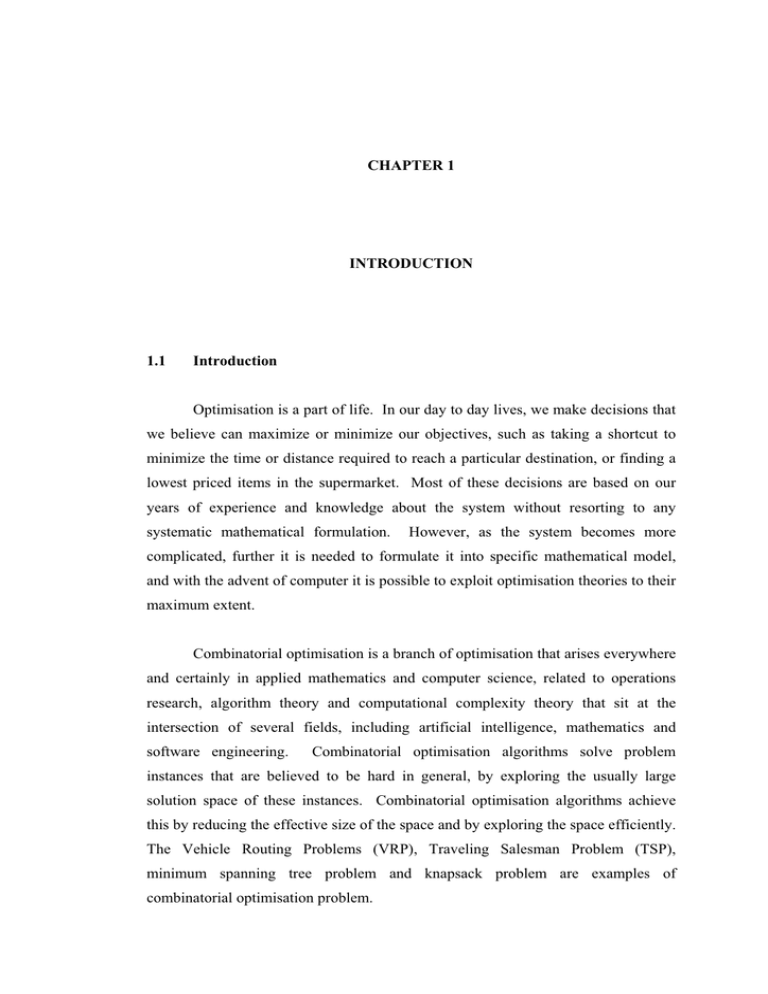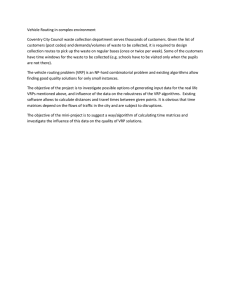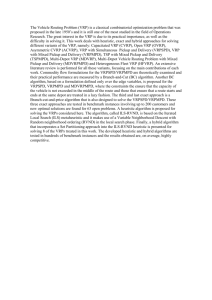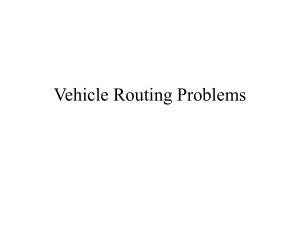1 Optimisation is a part of life. In our day... we believe can maximize or minimize our objectives, such as...
advertisement

1
CHAPTER 1
INTRODUCTION
1.1
Introduction
Optimisation is a part of life. In our day to day lives, we make decisions that
we believe can maximize or minimize our objectives, such as taking a shortcut to
minimize the time or distance required to reach a particular destination, or finding a
lowest priced items in the supermarket. Most of these decisions are based on our
years of experience and knowledge about the system without resorting to any
systematic mathematical formulation.
However, as the system becomes more
complicated, further it is needed to formulate it into specific mathematical model,
and with the advent of computer it is possible to exploit optimisation theories to their
maximum extent.
Combinatorial optimisation is a branch of optimisation that arises everywhere
and certainly in applied mathematics and computer science, related to operations
research, algorithm theory and computational complexity theory that sit at the
intersection of several fields, including artificial intelligence, mathematics and
software engineering.
Combinatorial optimisation algorithms solve problem
instances that are believed to be hard in general, by exploring the usually large
solution space of these instances. Combinatorial optimisation algorithms achieve
this by reducing the effective size of the space and by exploring the space efficiently.
The Vehicle Routing Problems (VRP), Traveling Salesman Problem (TSP),
minimum spanning tree problem and knapsack problem are examples of
combinatorial optimisation problem.
2
Since late fifties, the Vehicle Routing Problem (VRP) has been and remains a
rich topic for researchers and practitioners. It becomes an area of importance to
operations research as well as its use for many real world applications. An integral
component of logistics is transportation, and a frequently arising situation in the
transportation and distribution of commodities has usually been modeled as a
Vehicle Routing Problem (VRP). Usually real world VRP arises with many site
constraints. VRP is a generalized problem of the Traveling Salesman Problem (TSP)
in that the VRP consists in determining m vehicle, where a route is tour that begins at
the depot. The task is to visit a set of customer in a given order and returns to the
depot. All customers must be visited exactly once and the total customer demand of
a route must not exceed the vehicle capacity.
Given a set of geographically
dispersed customers, each showing a positive demand for a given commodity, the
VRP consists of finding a set of tours of minimum length (or cost) for a fleet of
vehicles. According to Secomandi (2003), the class of VRPs is a difficult one, since
its elements are usually NP-hard problems and they are generally solved by heuristic
methods. Lenstra and Kan (1981) has shown that VRP is NP-hard problem.
The majority of these researches conducted on operations research are focus
on static and deterministic cases of vehicle routing in which all information is
determined before the time of planning the routes.
Whereas in this ICT age,
information is gathered in real time and in many cases they are changing. The
complexity of the problem increases as more information is unavailable at the time
of the planning or when the service has begun such as the time to begin service, the
location and the actual demand. In most real life application, stochastic or dynamic
information occurs parallel to the routes being carried out. Many of the vehicle
routing problems have inherent randomness, which is not considered in deterministic
models, probably travel times or demands are random variables with known
distributions.
Tillman (1969) started the works to explore cases on VRP with
stochastic demands. Since that, many theories and algorithms on VRPSD have been
proposed and or developed. In this research, we are interested in studying the
demand as the stochastic component.
3
This chapter presents the flow of the research proposal and it begins with the
background and problem statement of the research. It is important that an extensive
work has been carried out in order to present a case for this work and this is given in
Chapter 2.
Research objectives, the scope of this study and discussion on the
research contribution are also given. Finally, the brief of each chapter is outlined.
1.2
Background of the problem
The classical VRP models usually do not capture an important aspect of real
life transportation and distribution-logistic problems, namely the fact that several of
the problem parameters (demand, time, distance, city location, etc) are often
stochastic. Most existing VRP models oversimplify the actual system by assuming
system parameter (e.g. customer demands) as deterministic value, although in real
application, it may not be possible to know all information about customers before
designing routes. Stochastic information occurs and has major impact on how the
problem is formulated and how the solution is implemented.
Neglecting the
stochastic nature of the parameters in a vehicle routing model may generate sub
optimal or even infeasible routes (Yang et al., 2000).
As compared to the development in deterministic case, research in Stochastic
VRP is rather undeveloped. Gendreau et al. (1996) summarise the solution concepts
and literature available on different kinds of SVRP including the TSP with stochastic
customers, the TSP with stochastic travel times, the VRP with stochastic demands,
the VRP with stochastic customers and the VRP with stochastic customers and
demands. Stochastic VRP cannot be solved as VRP since properties and the optimal
VRP solution do not hold for the SVRP (Dror et al., 1989). Further, it calls for more
complex solution methodologies (Gendreau et al., 1995).
This study focus on VRP with Stochastic Demands (VRPSD) in which
demand at each location is unknown at the time when the route is designed, but is
follow a known probability distribution.
This situation arises in practice when
whenever a company, on any given day, is faced with the problem of collection/
4
deliveries from or to a set of customers, each has a random demand. In this study,
we deal with specific case on solid waste collection. It is hoped that optimisation
can take into account the stochasticity of the problem in obtaining better routes and
reducing cost.
In stochastic environment, due to its randomness in customers’ demands, a
vehicle capacity may be exceeded during service. A route failure is said to occur if
the demand exceeds capacity and a recourse action needs to be taken at extra cost.
Assuming that enough capacity is available at the depot, the vehicle may return to
the depot, replenish its load, and then resume service at the point where failure
occurred. Therefore the vehicle will always be able to satisfy all demands but the
length of the corresponding tour becomes a random quantity.
The recourse action could be the vehicle resumes service along the planned
route, namely a priori approach, or visiting the remaining customers possibly in an
order that differs from the planned sequence known as re-optimisation approach.
There are two common recourse policies for a priori optimisation. The first is the
simple recourse policy (Dror et al., 1989; Gendreau et al., 1995; Chepuri and
Homem-de-Mello, 2005) where a vehicle returns to the depot to restock when its
capacity becomes attained or exceeded. The second approach is the preventive
restocking (Bertsimas et al., 1995; Yang et al., 2000; Bianchi et al., 2004) where
preventive restocking is planned at strategic points preferably when the vehicle is
near to the depot and its capacity is almost empty, along the scheduled route instead
of waiting for route failure to occur. On the other hand, most recent computational
studies in re-optimisation approach were done by Secomandi (2000, 2001, 2003).
In this study, we use a priori approach since redesign the routes when actual
demand becomes known appears to be a problem for several reasons:
1. Resources might not be available.
2. Even if resources are available, it might be that redesign of routes is not
sufficiently important to justify the required effort, cost and time.
3. Redesigning the route might create confusing to the driver.
5
4. Regularity and personalization of service by having the same vehicle and
driver visit a particular customer every day is not guaranteed if one redesigns
the routes.
For our case in solid waste collection, familiarity of driver and waste
collector on the route visited every day is highly emphasized; usually the route is
substantially not changed.
Redesign the routes might cause a problem in the
situation when demand is highly variable, thus the routes could be different each day,
creating route instability which has consequences to system nervousness in material
requirements planning. Further, if demand is stable, it still requires the company
personnel to understand day by day task of gathering and inputting new demand to
algorithm that generate routes and then deliver the output information to driver.
Tillman (1969) was the first to propose algorithm for the VRPSD in the case
where there were multiple terminal deliveries and multiple vehicles. Since then,
many researchers have studied this problem in two frameworks, namely the chance
constrained and stochastic with recourse. In the chance constrained VRPSD, the
problem is to design a number of vehicle routes of least distance traveled, subject to
the constraint that the probability of route failure on any route is within an allowable
limit. In contrast, VRPSD with recourse try to minimize the total expected cost (or
distance), including the cost of travel as well as the cost of recourse action when a
route failure occurs. The VRPSD with recourse is considerably more difficult than
chance constrained VRPSD (Gendreau et al., 1995).
Various formulations and algorithms have been proposed and investigated,
including the properties and solution frameworks of VRPSD studied by
Dror et al. (1989), Bertsimas (1992) who proposed cyclic heuristic and found a priori
solution for single vehicle and Dror et al. (1993) who have examined a priori
VRPSD in the context of Stochastic Programming where there is only one vehicle
and the number of potential failures is small. Yang et al. (2000) developed optimal
restocking policy in conjunction with routing decisions for a priori VRPSD for single
and multiple vehicles.
Secomandi (2001, 2003) considered re-optimisation-type
routing policy by means of rollout policy for single vehicle.
6
Bianchi et al. (2004) considered basic implementation of five metaheuristics
for single vehicle: Iterated Local Search, Tabu Search, Simulated Annealing, Ant
Colony Optimisation and Evolutionary Algorithm (Genetic Algorithm) that found
better solution quality in respect to cyclic heuristic. Chepuri and Homem-de-Mello
(2005) proposed a new heuristic method based on the Cross-Entropy method for
single vehicle. Instead of the work of Bianchi et al. (2004) and Gendreau et al.
(1995), the work on the application of GA and TS for VRPSD are lacking in the
literature. The work of Bianchi et al. (2004) results that the performance of GA and
TS seem to be not significantly different, due to the fact that these algorithms find
solutions values which are not very different to each other, but can not compete ILS.
These facts have opened a new direction to conduct research on GA and TS
for solving VRPSD.
Moreover, it is widely known that GA has been proven
effective and successful in a wide variety of combinatorial optimisation problems,
including TSP and certain types of VRP, especially where time windows are
included. TS, the approach that dominates the list of successful algorithms, is known
also as a robust, efficient and effective approach to the general VRP family of
problem (Laporte, 1992; Osman, 1993).
TS often outperform other heuristic
techniques in terms of computational speed and solution quality (Osman, 1993).
The number of published work on the application of GA for solving basic
VRP, TSP, VRPTW, VRPB, and multi depot VRP has been growing. Different
approaches were also proposed based on different crossover operator, different
mutation operator, or replacement methods.
Although pure GA performs well,
mostly it does not equal TS in terms of solution quality, sometimes pure GA perform
inefficient on practical combinatorial optimisation.
To improve pure GA
performance, some algorithms are combined with the simple GA, yielding a hybrid
algorithm.
The statement about GA hybridization is noted by Coley (1999) that hybrid
algorithms, which combine a GA with more traditional algorithms, have been hinted
as a highly powerful combination for solving practical problem, also by Lacomme et
al. (2006) that it is well known that a standard GA must be hybridized with another
search procedure to be able to compete with metaheuristics like TS. Baker and
7
Ayechew (2003) showed that hybrid GA with neighbourhood search in the basic
VRP is competitive with TS and SA in terms of solution time and quality. Hybrid
GAs also have widespread application to VRPTW, including the work of Blanton
and Wainwright (1993), Thangiah (1995a and 1995b), Berger et al. (1998) and
Braysy et al. (2000).
Based on previous research on algorithms developed for VRPSD and the
knowledge of the basic structure of GA and TS, in this study we develop
metaheuristics based on GA and TS as the enhancement of basic GA and TS for
solving single and multiple VRPSD in minimizing single objective function. Our
reviews also found that hybrid GA has not been used to solve VRPSD and most of
researches in VRPSD with preventive restocking are dealing with single VRPSD and
little work has been done for multiple VRPSD, even though decisions relating to
routing fleets of vehicles are frequently taken into consideration in distribution and
logistics operations. This brings us to also develop the meta-heuristics based on
hybrid GA and TS to solve a priori VRPSD comprises single vehicle and multiple
vehicles.
The approach developed was inspired also by the emerging interest in hybrid
metaheuristics that has risen considerably among researchers in combinatorial
optimisation. The best results found for many practical or academic optimisation
problems are obtained by hybrid algorithms (Talbi, 2002). In this study, the GA will
be hybridized with TS. It is highly expected that this hybrid could combine the
advantage of GA as population-based method and the strength of TS as trajectory
method. As known, population-based methods are better in identifying promising
areas in the search space, whereas trajectory methods are better in exploring
promising areas in search space.
In this study, we also propose metaheuristics for solving bi-objective VRPSD
to minimize the total expected cost and the number of vehicles. This study is
motivated by fact that many real world design or decision making problems involve
simultaneous optimisation of multiple objectives (Srinivas and Deb, 1994). But most
of the existing literatures in VRPSD, except of multi-objective’s Tan et al. (2007),
use single-objective based heuristics. In a single-objective optimisation, the main
8
goal is to find the global optimum solution.
However, in a multi-criterion
optimisation problem, there are more than one objective function, each of which may
have different individual optimal solution. If there is sufficient difference in the
optimal solutions corresponding to different objectives, the objective functions are
often conflict each other.
Multi-criterion optimisation with such conflicting
objective functions gives rise to as set of optimal solutions, instead of one optimal
solution. The reason for the optimality of many solutions is that none can be
considered to be better than any other with respect to all objectives.
1.3
Problem Statement of Research
The VRPSD is defined on a complete graph G = (V, A, C), where
V = {0, 1,…, n} is a set of nodes with node 0 denotes the depot and nodes
1, 2, …, n correspond to the customers,
A = {(i, j ) : i, j V , i z j} is the set of arcs joining the nodes, and
C = ( cij : i, j V , i z j} ) is a non-negative matrix (a matrix where all the
elements are equal to or above zero, C t 0, (i, j ), cij t 0 ) that denotes the travel
cost (distance) between node i and j.
The cost matrix C is symmetric and satisfies the triangular inequality. Customers
have stochastic demands [ i , i = 1,…, n, which are a non-negative discrete random
variable with known probability distribution pik
Pr ob([ i
k ) , k = 0, 1,…, K d Q.
Assume further that customers’ demands are independent and identical. Actual
demand is only known after the vehicle arrives at customer’s location. If there is a
route failure at any node, the recourse action has to be taken, the recourse action is to
travel back to the depot for replenish and then resume its journey as planned at the
node where failure occurred. The problem objective is to find a priori routes that
minimize the total expected cost, including travel cost and the expected recourse
cost, subject to the routing constraints, under the stochastic demands setting.
9
A stochastic vehicle routing problem arises when not all information relevant
to the planning of the routes is known by the planner when the routing process
begins and information can change after the initial routes have been constructed.
According to Secomandi (2003), for the class of deterministic VRPs, they are
generally solved by heuristic or metaheuristic methods; whereas algorithms for
stochastic VRP are considerably more intricate than deterministic and it calls for
efficient algorithm that is able to work in real-time since the immediate requests
should be served. These have made them an important candidate for solution using
metaheuristics.
This research tries to propose new metaheuristics based on GA and TS to
enhance the performance of basic GA and basic TS for solving VRPSD. In this
work, we initially consider a single-vehicle model and later expand the analysis to
incorporate multiple vehicles.
We also develop metaheuristics for solving bi-
objective VRPSD. The performances of the proposed algorithms were compared
each other and with other heuristics/ metaheuristics. The implementation of these
algorithms also will be done to solve real problem in optimizing solid waste
collection.
1.4
Objectives of the Study
The aim of this study is to develop various approaches to optimize VRPSD
solution, particularly in the use of metaheuristics approach. The objectives of this
study are to:
x
develop metaheuristics for solving single VRPSD that include:
a. Tabu Search and Reactive Tabu Search.
b. Genetic Algorithm and the enhanced GA, i.e. :
-
Adaptive Genetic Algorithm
-
Breeder Genetic Algorithm and
-
Hybrid GA and TS
10
x
develop GA-based metaheuristic for solving bi-objective multiple VRPSD.
x
conduct comparative evaluation on the performance among these
metaheuristics.
x
solving real problem data in optimizing solid waste collection by using the
VRPSD model and the developed metaheuristics.
1.5
Scope of the Study
1.
In this research, we confine the application of our algorithm to a priori
VRPSD under restocking policy.
2.
The problem data for the performance testing in simulation study are
randomly generated problem data following specific probability distributions.
3.
We confine our real problem solving in the case study of optimizing solid
waste collection.
4.
It is assumed that vehicles start and end at a single depot.
5.
It is assumed that every customer demands have the same probability
distribution but can have different parameters (for example: different mean
and variance for each customer that have normal distribution).
6.
The problem data were generated using Minitab version 14 and were tested
and analyzed using SPSS version 13 for Windows, while the implementation
of metaheuristics was done using Delphi version 6.0. Minitab has special
feature in generating random data following specific probability distribution
which SPSS does not have, while SPSS has advantage in better graphical
representation of the output of data analysis than Minitab.
7.
The stopping criteria in addressing convergence for all procedures presented
in this study will not using numerical analysis component/ complexity
analysis.
11
1.6
Significance of the Study
1.
From the view point of algorithm development: our algorithms are the first
implementation of
-
Reactive Tabu Search,
-
Adaptive GA,
-
Breeder GA,
-
and hybrid GA (especially hybrid GA with Tabu Search)
for solving single and multiple vehicles appeared in the VRPSD literature.
2.
We also propose the new adaptive mutation probability measure.
3.
We contribute on the first considering bi-objective VRPSD under restocking
policy and proposing new GA-based for solving bi-objective multiple
VRPSD.
4.
From application aspect, real problem in optimizing waste collection was
solved by using the proposed algorithm.
5.
We also develop software package for solving VRPSD.
6.
And the result of this study will be presented and published at the
international publications/ journal.
Along the recent increase in the demand for an efficient management system
for VRP and logistics and the advances in computer and information technology, the
importance of being able to effectively make use of the huge amount of information
has become important for a wide range of applications. Cost efficient routing of
vehicles play an important role to a wide range of industries. As indicated earlier,
our focus would be to work on the problem related to VRP for solid waste collection
in the Municipality of the Johor Bahru city.
1.7
Organisation of the Thesis
This thesis contains eight chapters. The first chapter is the introduction. This
chapter gives an introduction to the background of the problem, the statement of the
problem, objectives and scope of the study, and significance of the study.
12
Chapter two is the Literature Review. This chapter presents a literature
review about the Vehicle Routing Problem with Stochastic Demands, solution
techniques appeared in literature and also techniques which may be applied for
solving VRPSD.
Chapter three is the Research Methodology.
This chapter presents the
direction of the study and an overview of the methods used. It begins with the
general steps of research framework. A description of the data source for this study
and test related to it are also presented include case-study of a real-life application at
solid waste collection company (Perniagaan Zawiyah Sdn. Bhd). It follows with the
description of algorithm implemented with emphasis on Genetic Algorithm, Tabu
Search and the enhancement of these two metaheuristics.
In Chapter four, the development of metaheuristic methods based on Tabu
Search and Reactive Tabu Search for solving single VRPSD are explored. The
discussion of this chapter begins with the detail development of Tabu Search and
Reactive Tabu Search for single VRPSD, followed by the experimental results and
discussion.
Chapter five discusses the development of several Genetic Agorithm-based
metaheuristics for solving single VRPSD.
The standard Genetic Algorithm is
presented, followed by the enhancement of it through Adaptive Genetic Algorithm,
hybrid Genetic Algorithm with Tabu Search, and the Breeder Genetic Algorithm.
Chapter six considers multiple VRPSD which analog of the deterministic
VRP. The use of Breeder Genetic Algorithm is proposed to solve the bi-objective
VRPSD in minimizing the number of vehicles required and the total expected cost
concurrently, using Pareto-rank by modifying and extending the single-objective
Breeder Genetic Algorithm.
VRPSD finds its application on wide range of logistics and distribution sector
in cases where it is impossible to know the demand of the customers before the
vehicles arrives at customer’s location. In Chapter seven, the implementation of
13
VRPSD in the case of picking up of garbage done by solid waste company in Johor
Bahru namely Perniagaan Zawiyah Sdn. Bhd. is discussed.
Finally, Chapter eight concludes the relevant and important findings from this
research. Recommendations on area related to the findings and possible directions
for future research are presented.





